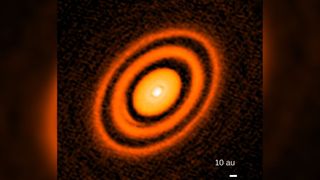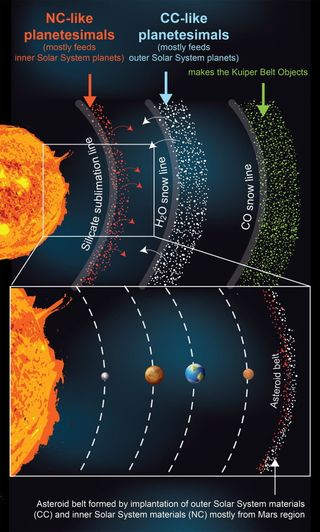The sun used to have rings like Saturn
Those rings of dust may have prevented Earth from growing into a "super-Earth."

Before Earth and the other planets in our solar system existed, the sun may have been surrounded by giant rings of dust similar to Saturn's, according to a new study.
Those rings of dust may have prevented Earth from growing into a "super-Earth" — a type of planet that is about twice the size of Earth and up to 10 times its mass, according to NASA. Astronomers have discovered super-Earths orbiting about 30% of sun-like stars in our galaxy.
The occurrence of super-Earths in so many other solar systems left astronomers with some unanswered questions: namely, "if super-Earths are super-common, why don't we have one in the solar system?" André Izidoro, an astrophysicist at Rice University in Houston, Texas, said in a statement. To find out, Izidoro and his colleagues created a computer simulation model of the formation of the solar system, which emerged from the ashes of a collapsed cloud of dust and gas known as a solar nebula, Live Science previously reported.
Related: 7 ways the Earth changes in the blink of an eye
Their simulations suggested that pressure "bumps," or high-pressure regions of gas and dust, would have surrounded the infant sun. These areas of high pressure likely resulted when particles moved toward the sun under its strong gravitational pull, heated up and released large amounts of vaporized gas.
The simulations showed that there were likely three distinct areas where solid particles vaporized into gas, called "sublimation lines." In the line closest to the sun, or the hottest zone, solid silicate turned into gas; in the middle line, ice would have heated up enough to turn into gas; and in the farthest line, carbon monoxide became a gas.
Solid particles like dust sort of rammed into these "bumps" and began to accumulate, the simulations showed. "The effect of the pressure bump is that it collects dust particles, and that's why we see rings," co-author Andrea Isella, an associate professor of physics and astronomy at Rice University, said in the statement. If these pressure bumps didn't exist, the sun would have quickly gobbled up the particles, not leaving any seeds for the planets to grow. "One needs something to stop them in order to give them time to grow into planets," Isella said.
Get the Space.com Newsletter
Breaking space news, the latest updates on rocket launches, skywatching events and more!

With age, the gas and dust surrounding the sun cooled down and the sublimation lines inched closer to the sun. This process allowed the dust to accumulate into planetesimals, or asteroid-size seeds of planets, which could then come together to form planets. "Our model shows pressure bumps can concentrate dust, and moving pressure bumps can act as planetesimal factories," Izidoro said.
The pressure bumps regulated how much material was available to form planets in the inner solar system, Izidoro said in the statement.
According to the simulations, the nearest ring to the sun formed the planets of the inner solar system — Mercury, Venus, Earth and Mars. The middle ring would ultimately become the planets of the outer solar system, while the outermost ring formed the comets, asteroids and other small bodies in the Kuiper Belt, the region beyond the orbit of Neptune.
What's more, the researchers found that if they simulated the delayed formation of the middle ring, super-Earths may have formed in the solar system. "By the time the pressure bump formed in those cases, a lot of mass had already invaded the inner system and was available to make super-Earths," Izidoro said. "So the time when this middle pressure bump formed might be a key aspect of the solar system."
The findings were published Dec. 30 in the journal Nature Astronomy.
Originally published on Live Science.
Join our Space Forums to keep talking space on the latest missions, night sky and more! And if you have a news tip, correction or comment, let us know at: community@space.com.


